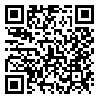BibTeX | RIS | EndNote | Medlars | ProCite | Reference Manager | RefWorks
Send citation to:
URL: http://jgs.khu.ac.ir/article-1-2735-en.html
2- MSc student of Remote Sensing, Tabriz University
3- Associate professor of geomorphology at Tabriz University.
Remote sensing technology is one of the most efficient and innovative technologies for agricultural land use/cover mapping. In this regard, the object-based Image Analysis (OBIA) is known as a new method of satellite image processing which integrates spatial and spectral information for satellite image process. This approach make use of spectral, environmental, physical and geometrical characteristics (e.g. texture, shape) together images contexts for modeling of land use/cover classes. The main objective of this study is to classify micro land use/cover of Meyandoab County by applying appropriate and effective algorithms and parameters in the object based approach. For this goal, Quick Bird and Aster satellite images were used within the integrated approach for processing and land use modeling. Accordingly, the land use map was classified in 9 class based on spectral and spatial characteristics. In order to perform OBIA, the segmentation was applied in the scale of 10, shape parameter of 0.7 as well as the compactness of 0.3. In terms of the classification task, fuzzy based algorithm and operators (AND, OR) was applied to detriment the membership functionality of segments for each class as well as classifying the related objects. We also applied textures, geometric, NDVI, GLCM, brightness algorithms based on fuzzy operators and assign class algorithm. In order to applying the validation of results, the accuracy assessment step was performed and the finally overall accuracy of 93.6 was obtained for the derived map. The Kappa coefficient was also detriment to be 0.92. The area under cultivation included respectively for lands of wheat and barley, prunes and plums, apples, vineyards and alfalfa hay2622.42, 4505, 4354.55, 4457.85, 14110.58 hectares.
| Rights and permissions | |
 |
This work is licensed under a Creative Commons Attribution-NonCommercial 4.0 International License. |

This work is licensed under a Creative Commons — Attribution-NonCommercial 4.0 International (CC BY-NC 4.0)






